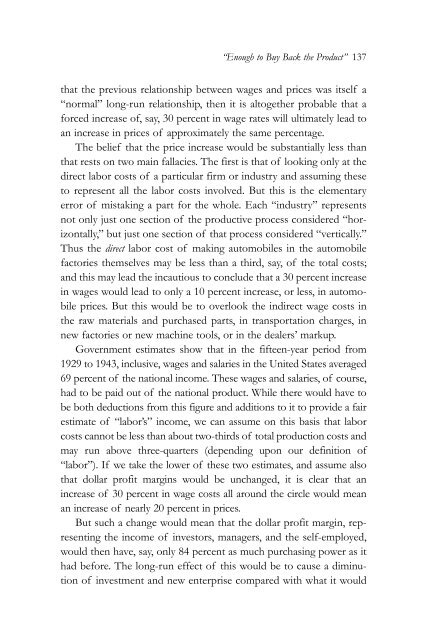1gDdM7w
1gDdM7w
1gDdM7w
- No tags were found...
You also want an ePaper? Increase the reach of your titles
YUMPU automatically turns print PDFs into web optimized ePapers that Google loves.
“Enough to Buy Back the Product” 137that the previous relationship between wages and prices was itself a“normal” long-run relationship, then it is altogether probable that aforced increase of, say, 30 percent in wage rates will ultimately lead toan increase in prices of approximately the same percentage.The belief that the price increase would be substantially less thanthat rests on two main fallacies. The first is that of looking only at thedirect labor costs of a particular firm or industry and assuming theseto represent all the labor costs involved. But this is the elementaryerror of mistaking a part for the whole. Each “industry” representsnot only just one section of the productive process considered “horizontally,”but just one section of that process considered “vertically.”Thus the direct labor cost of making automobiles in the automobilefactories themselves may be less than a third, say, of the total costs;and this may lead the incautious to conclude that a 30 percent increasein wages would lead to only a 10 percent increase, or less, in automobileprices. But this would be to overlook the indirect wage costs inthe raw materials and purchased parts, in transportation charges, innew factories or new machine tools, or in the dealers’ markup.Government estimates show that in the fifteen-year period from1929 to 1943, inclusive, wages and salaries in the United States averaged69 percent of the national income. These wages and salaries, of course,had to be paid out of the national product. While there would have tobe both deductions from this figure and additions to it to provide a fairestimate of “labor’s” income, we can assume on this basis that laborcosts cannot be less than about two-thirds of total production costs andmay run above three-quarters (depending upon our definition of“labor”). If we take the lower of these two estimates, and assume alsothat dollar profit margins would be unchanged, it is clear that anincrease of 30 percent in wage costs all around the circle would meanan increase of nearly 20 percent in prices.But such a change would mean that the dollar profit margin, representingthe income of investors, managers, and the self-employed,would then have, say, only 84 percent as much purchasing power as ithad before. The long-run effect of this would be to cause a diminutionof investment and new enterprise compared with what it would


